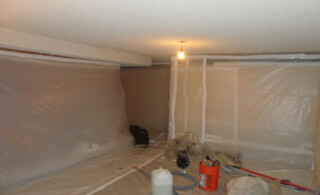
Radon is a radioactive gas that can be found in any home, new or old. This toxic gas comes from decomposed uranium in the soil, and since it always moves from the ground into the air above, it often leaks into houses through cracks in the foundation. However, you cannot see, smell, or taste this gas, which means that even though it is dangerous and cancerous if it builds up in the home, it can never be detected unless special procedures are enforced, such as occasional radon system testing.
Radon Testing
This test can take on many forms for a variety of different purposes. If you are buying or selling a house, it is always a good idea to hire professionals to inspect the property. Although this is more expensive, these qualified experts have specialized equipment that actively analyze the gas levels within a couple of days and officially report this information to the prospective buys. However, the most common form of radon testing comes in passive kits that any homeowner can use themselves.
Passive Kits
These devices are inexpensive and available in either short or long-term models. Short-term models are great to get a quick idea of gas levels within a few days, but since these levels change daily these kits won’t give extensive results. They’re dependable but not reliable over long periods of time. Long-term kits stay in your house for a few months and give a better idea of yearly gas levels. Here are a few do-it-yourself kit options to choose from:
- Charcoal: This is the most common device on the market, and is often a short-term device. It arrives in a packet filled with charcoal and should be put on a first floor level, several feet above the floor (most come with hooks for easy hanging), where they then collect radon atoms from the surrounding air. Follow the instructions on the packet, but once the time period is up (could be up to 90 days), simply mail the packet back to the company where they will analyze the gas levels in a lab and inform you of the results.
- Alpha-Track: This is often a long-term device and works similarly to charcoal, but instead a plastic strip collects alpha particles from the gas. Though they stay in the house longer, the results they generate will give you a larger scope of the gas levels in your home once you send the packet into the lab.
- Radon Detector: This passive device still inspects, but unlike kits, it continually stays in the house. Often plugged into a regular socket in the basement, a radon detector will sound off an alarm when gas levels get to high. It can be set at both a short-term or long-term settings, and is a great precautionary measure to in ensure your home’s safety.
Ready to start your Radon Testing?
Find ProsRadon Mitigation
According to the EPA, if these gas levels ever reach 4 pCi/L (the scientific measure of radon) then you have a hazardous amount of toxins in the air. But once you’ve gotten these results back, the question remains: How do you get rid of the stuff? Oddly enough, it doesn’t really help to reseal your home’s gaps, cracks, and fissures. This only makes the gas build up underground in larger concentrations, which will allow it to ultimately seep back into your house at higher levels. Instead, the best form of radon mitigation is to prevent the toxins from ever reaching your house, usually through some type of exhaust system. Here are a few radon mitigation methods available:
- Sub-slab Depressurization: The most common method which uses pipes and fans installed below the basement to trap and vent contaminated air outside before it enters the home.
- Soil-depressurization: A method that aerates the actual soil around the home, reducing hazardous gas levels.
- Heat-Recovery Ventilators: Ventilators by bringing fresh outdoor air into the home, thereby decreasing indoor toxins. However, this outdoor air is heated or cooled before entering the house in order to keep your thermostat stable, which can add to your energy bills.
Always consult a professional contractor beforehand to make sure you’re getting the appropriate equipment to fit your house. Plus, these contractors can also install the apparatus for you to ensure quality performance. Although this project may not be a cheap purchase (it usually costs around $800), it is very important to not skimp on a good radon system. Proper investment is priceless when it comes to proper prevention.
 Lead Paint Common Sense
Lead Paint Common Sense  How Do I Get Rid of the Moldy Odor in My Basement?
How Do I Get Rid of the Moldy Odor in My Basement?  Guide to Room-by-Room Repairs for Easy Accessibility for Disabled Loved Ones
Guide to Room-by-Room Repairs for Easy Accessibility for Disabled Loved Ones  Pool Safety Guide for Homeowners
Pool Safety Guide for Homeowners  Asbestos Removal: A Primer
Asbestos Removal: A Primer 

Are You Familiar With This Topic? Share Your Experience.